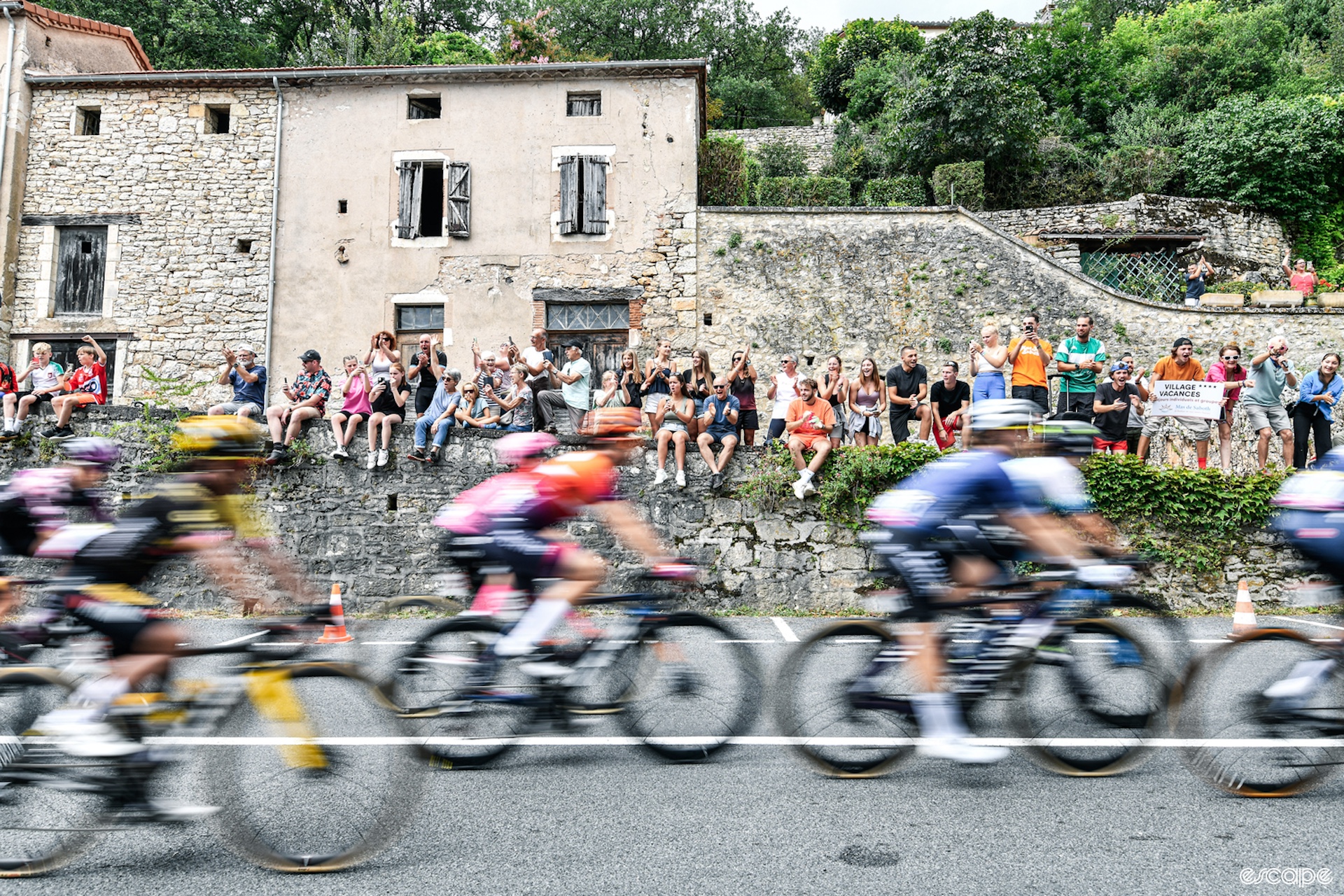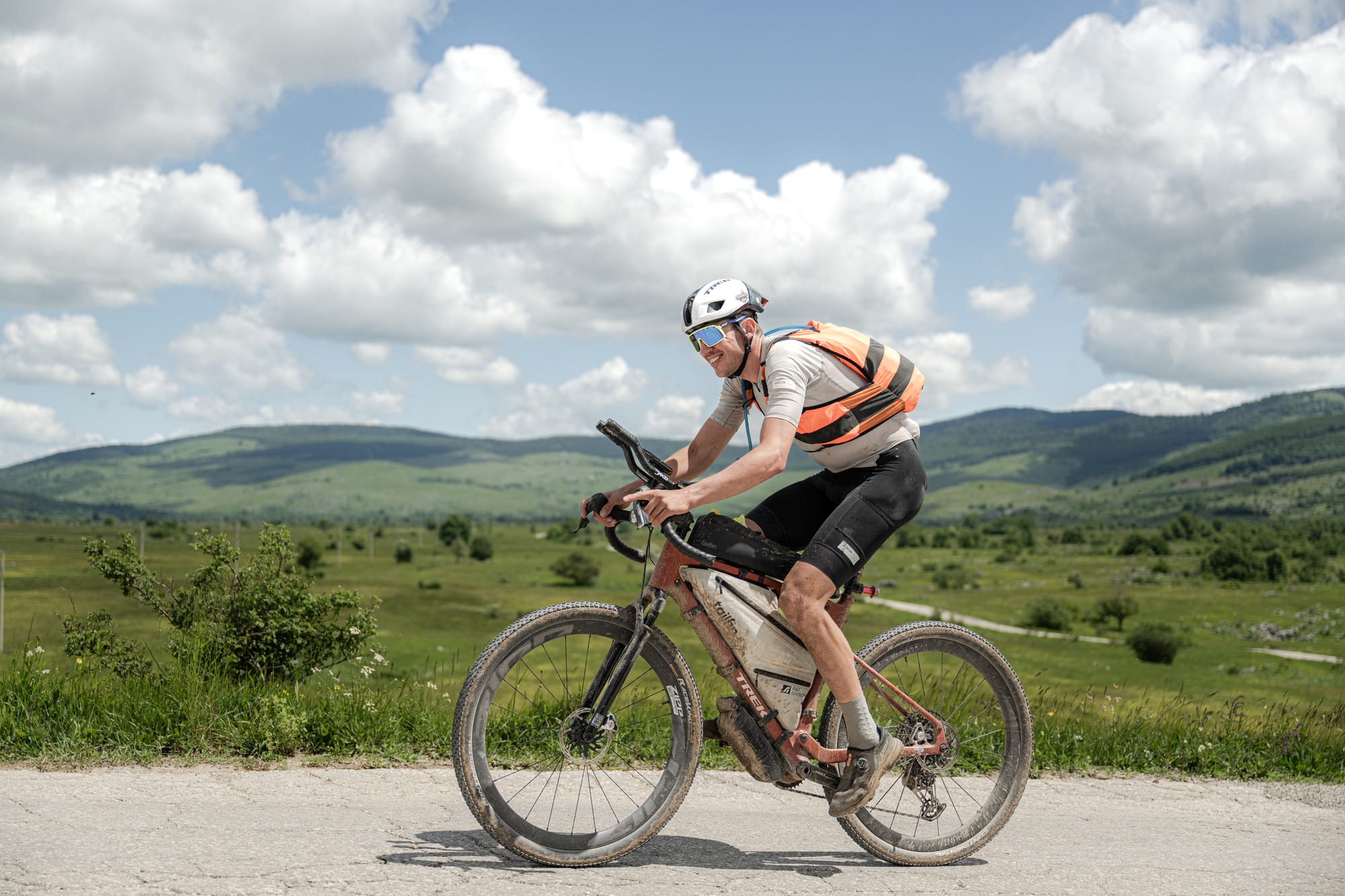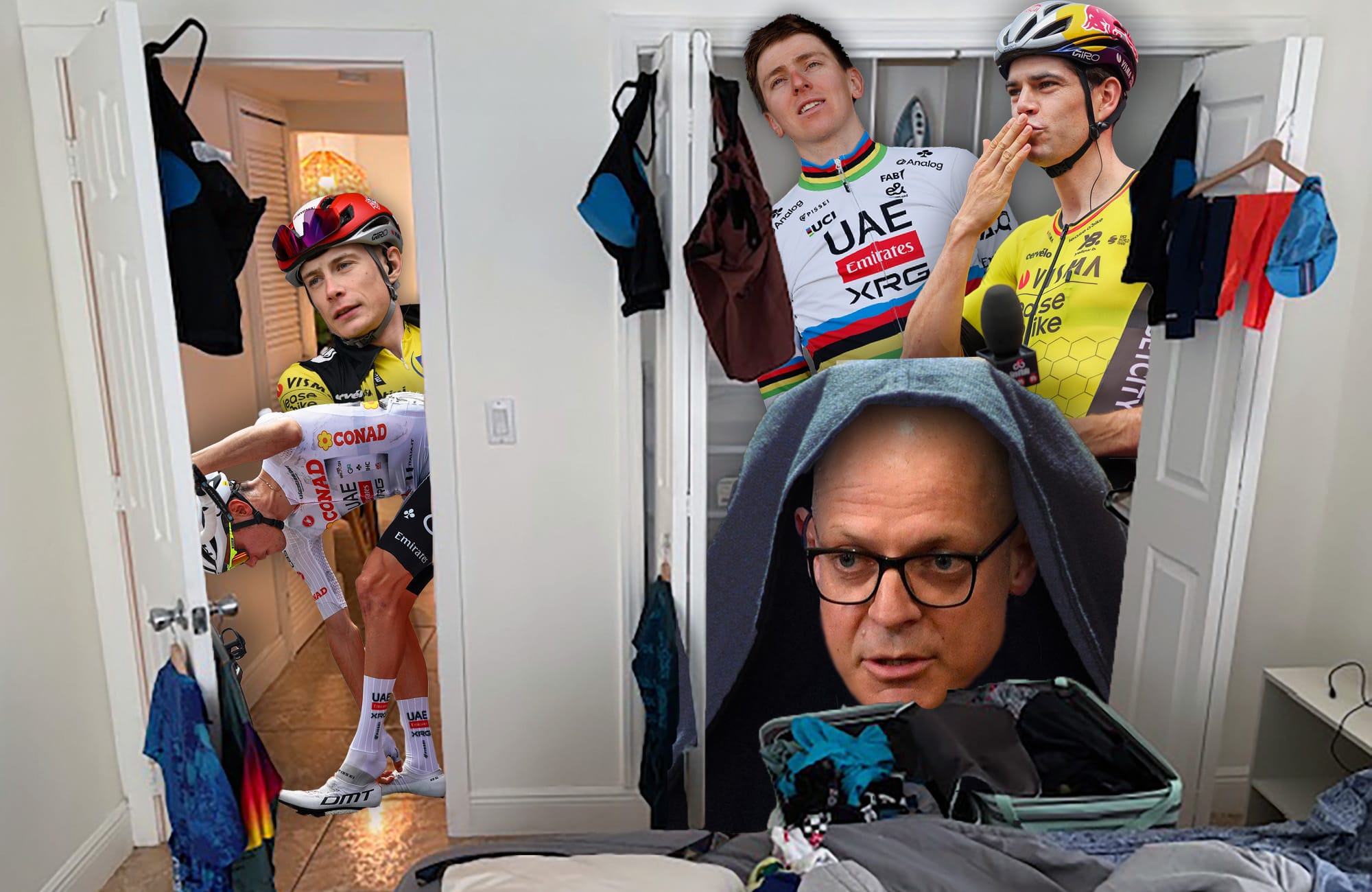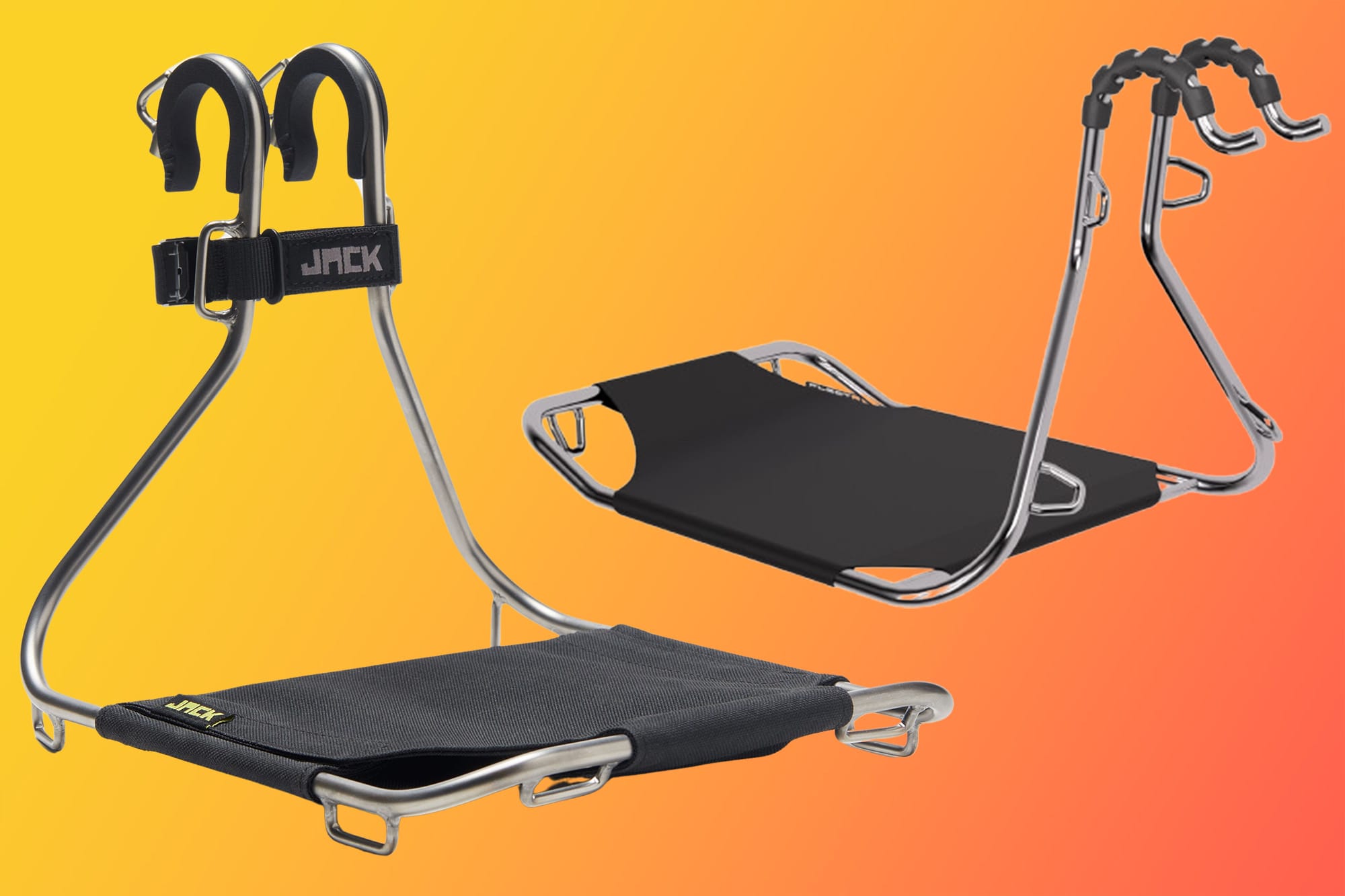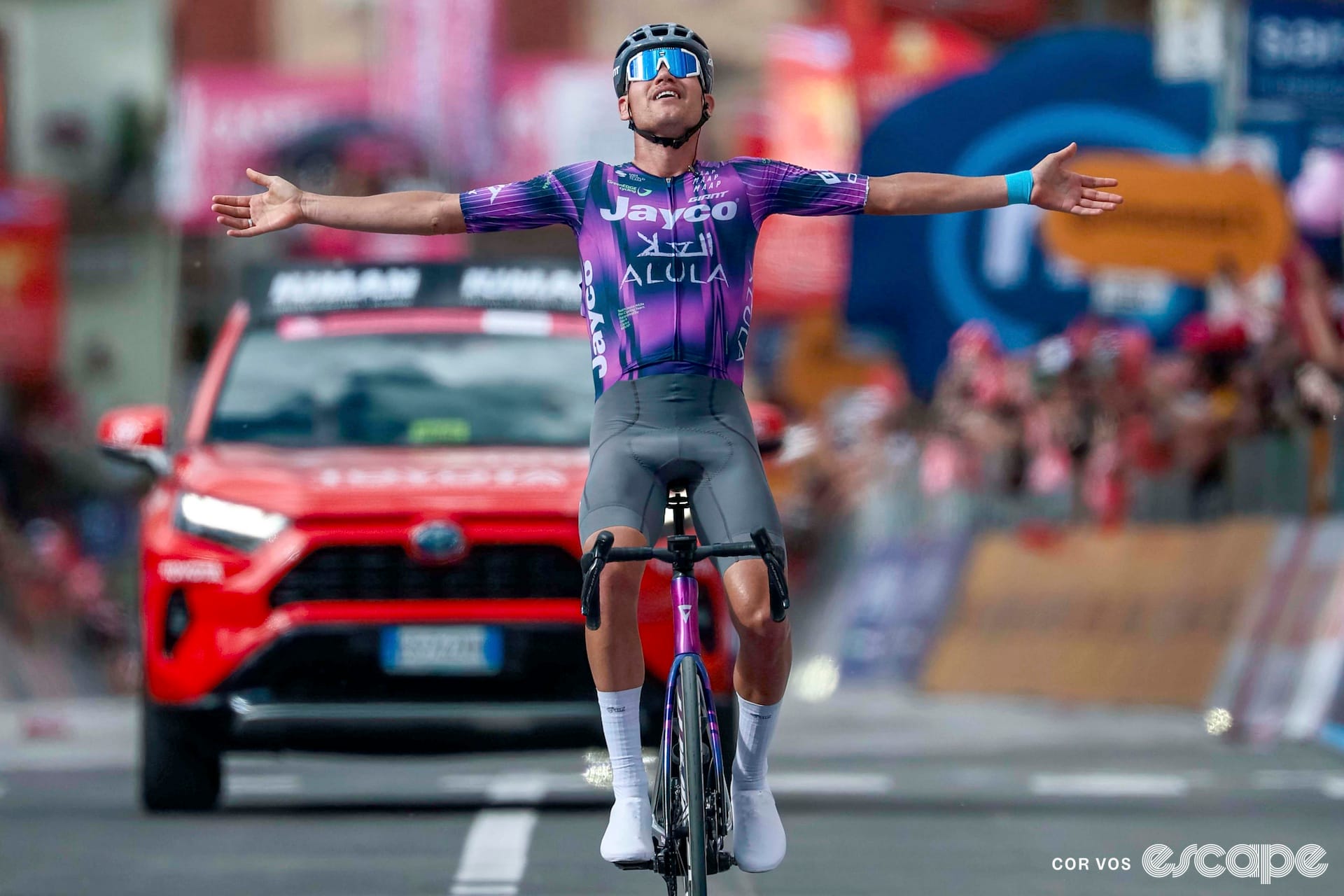Two years after its inaugural event the Tour de France Femmes avec Zwift has already taken hold of women's cycling. As the third edition approaches, the impact of the race is palpable. Riders and teams plan their whole year around the race, but this year is especially significant as the Tour will take place shortly after the Olympic Games in Paris. Top riders from every country first lined up to compete for their homelands on the streets of Paris in the women's road race before hopping over to the Netherlands for the start of the biggest stage race on the calendar.
Accommodating the Olympics also means the race sits later in the season for 2024. With the Games starting mere days after the men's Tour wrapped up, there was no way to host an eight-day stage race directly after the men's. Instead, the race takes place three weeks after the men's event. This means even more distance between the two races, and more opportunity for the women's event to stand on its own.
The Olympics also meant the TdFF couldn't take place wholly in France. With so much of France's resources going into the Olympic Games, the women's Tour had to start elsewhere, and where better to host the Grand Depart than one of the most cycling-mad nations in the world? Three of the eight stages will take place in the Netherlands and the fourth is mostly in Belgium before the women will finally set wheel in France for the finish of stage 5.
Like the last two editions, the course builds throughout the week, with some flat or hilly stages to open the week and two brutal mountain stages at the very end. The yellow jersey could change hands daily, especially with a short time trial on the second day of the race. There is a lot to look forward to this year.
How to watch
Streaming: 🇬🇧 🇪🇺 Discovery+/Eurosport; 🇺🇸 Peacock; 🇦🇺 SBS; 🇨🇦 FloBikes
Start and finish times will vary slightly each day but, with the exception of Tuesday's double-stage day and the final stage, expect stages to finish around 15:00-16:00 CET. The final stage atop Alpe d'Huez should finish around 18:00 CET.
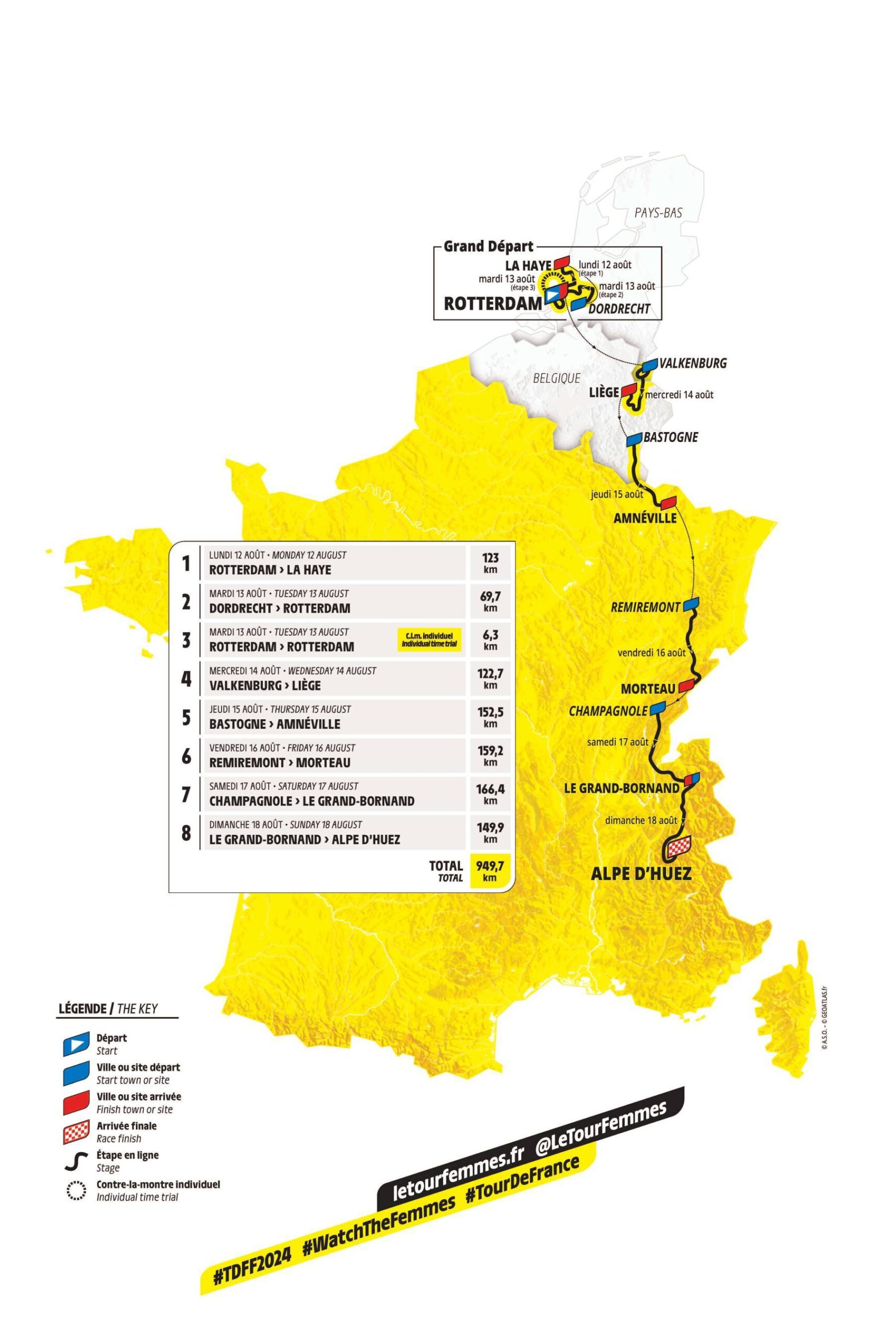
Play our Tour Fantasy game!
How did your fantasy Giro d'Italia go? Good news, you can try again! With the Tour de France Femmes. We are once again playing our Fantasy games, where you can select a winner for each stage and try to build up points. Challenge your friends to join a league, eternal bragging rights are on the line.
If you’re not sure how to play, here’s a handy-dandy guide for you.
You’ll find the game here, or you can download the Escape Collective app from the App Store (iOS) or the Play Store (Android).
Stage 1: Rotterdam to La Haye (123 km)
Date: Monday, August 12
Stage type: Flat
Summary: The fastest women will go as fast as they can to win the first yellow jersey on offer.
The opening stage for the Tour will have the sprinters positively salivating, and since the top two sprinters in the peloton are Dutch, even more so. It's a flat stage, starting in Rotterdam and ending in The Hague on the coast, and pretty technical as well. The stage is constantly changing direction, so there is probably a limited chance of echelons, but since it's the Netherlands, the possibility is never zero.
There is one climb, a Cat 4 that lasts 1 km and averages 3.1%. It's not much, but there will be plenty of riders who want that Mountains Classification jersey on the first day, so expect a fight.

In total the stage boasts just 122.8 meters of elevation gain; to say it's flat is an understatement. However, the most significant "climb" on the course is at the finish. The stage doesn't finish in a town centre, but rather at the end of a street that goes to the beach. It will be picturesque, that's for sure.
The final 270 meters of the race averages 1.6%, which sounds like nothing, but it is still more challenging than a flat as flat can be finish.
The final 40 km is technical, the road is constantly twisting. With 30 km to go, there are some really sharp turns before the race enters The Hague and completes a little lap around the town, including a tour through a local park. Once the race reaches the final 5 km there are only two turns left, which means the finish will favour sprinters whose teams can stay together, and keep cool, during a fast run-in. Teams will want to be together and organized with 30 km to go already, so by the final 3 km, it will be up to the most cohesive teams to deliver their sprinter to the line.
Stage 2: Dordrecht to Rotterdam (69.7 km)
Date: Tuesday, August 13
Stage type: Flat
Summary: A chance for the women who missed out on stage 1 to make up for it.
The second day of the Tour de France Femmes is a two-stage day. Yep, double up with two stages in one day. The first is a short, flat mass-start race. At 70 km and with 69.5 metres of elevation gain the race is another one for the sprinters.
The women will roll out of Dordrecht early on Tuesday for the second stage and race to Rotterdam, where they will start the time trial later the same day.
This can't be stressed enough. Tuesday = two stages in one day.
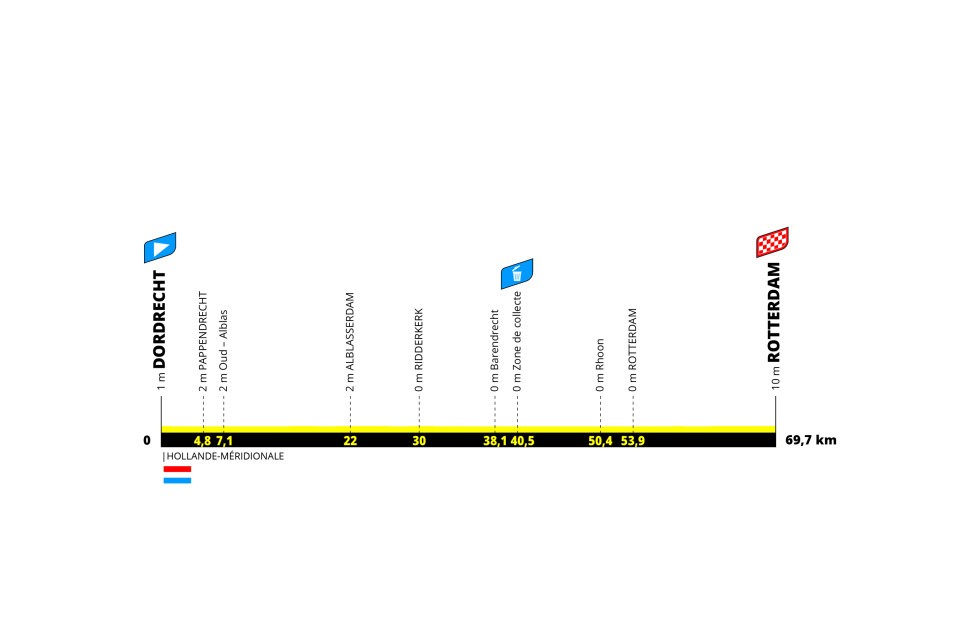
In another pan-flat stage, the sprinters will once again be fighting to win, but since the stage is so short it's guaranteed to be a fast one. Don't expect a breakaway to go on this stage, and if it does, it will be kept on a short leash. However, because the day as a whole is a bit of a weird one, there is a possibility the sprinter's teams mistime their lead-outs or a chase.
With 5 km to go the race enters Rotterdam, and from there it is technical. Unlike the stage before it, the second stage will be a real battle for position in the finale. The women enter Rotterdam and do a tricky little clockwise route that contains five turns within 2.8 km from the finish. The final 1 km, however, is a straight shot to the line.
Stage 3: Rotterdam to Rotterdam (6.3 km)
Date: Tuesday, August 13 (DOUBLE DAY!)
Stage type: ITT
Summary: An opportunity for the riders to test themselves (and their fueling strategy) against the clock.
For the second race of the day, the women won't be out there on the roads for long. The time trial this year is barely longer than an official prologue at 6.3 km, and as expected from the previous two days, it's flat. There are only two rises in the profile, but on closer look, they are actually bridges over the Nieuwe Maas river. This is going to be a rapid race, with track riders (who chose to race the Tour after the Olympics) and time trialists alike fighting for a stage win.
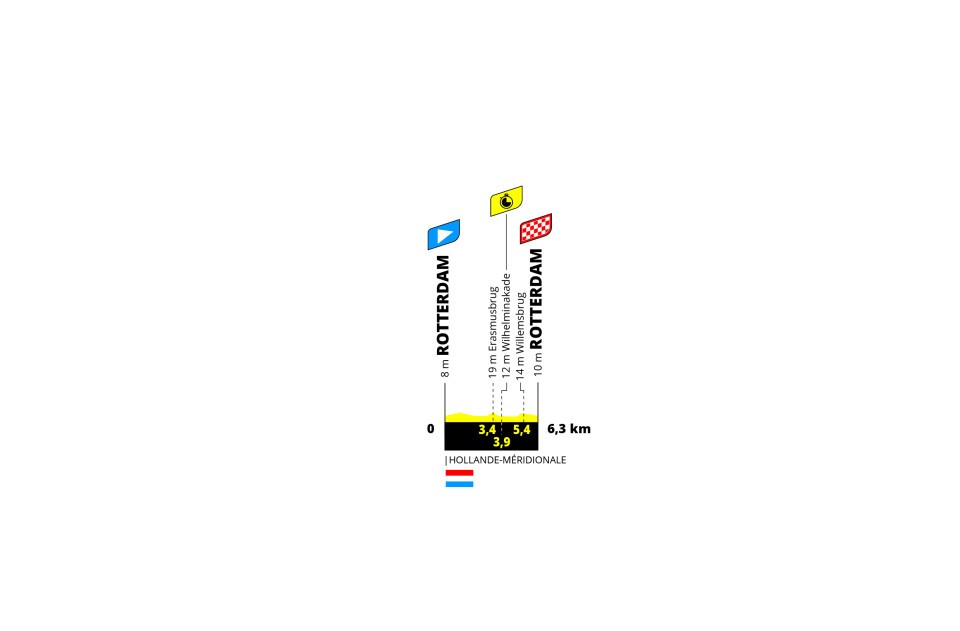
To put timing into perspective, the 4.8 km ITT that opened the Giro in 2022 was won by Kristen Faulkner in 5:45. Second behind the American was Georgia Baker, four seconds down. The 6.3 km effort will likely be well under 10 minutes. It's important to factor in that the riders will have raced 70 km in the morning, so there are more factors at play than would normally be in a time trial. Fatigue, how the riders managed their recovery post-stage, fueling pre-stage 2 and after will be massively important. It's a short effort, but if fueling for the entire day starting after stage 1 isn't done properly, it will end in a longer effort on Tuesday evening.
Because the effort is so short, it will not massively impact the general classification. Seconds will be lost here and there, but it will not be a make-or-break situation.
Stage 4: Valkenburg to Liège (122.7 km)
Date: Wednesday, August 14
Stage type: Hilly
Summary: The first hills of the race could see the yellow jersey change hands.
The fourth stage from Valkenburg to Liège covers many of the Classics climbs the riders will be familiar with, albeit in the July heat instead of the spring meh. The opening four climbs, three Cat 4s and a Cat 3 are normally covered in the Amstel Gold Race in April, but where the Amstel Gold Race finishes, stage 4 will begin.
After rolling out of Valkenburg the first climb of the day is just 6.6 km into the race. The Bemelerberg, a 1.3 km ascent of 4.9%, is immediately followed by the Cauberg (700 m, 8%), Geulhemmerberg (1.1 km, 5.1%) before looping around to race up the Bemelerberg again.
From there the women have a 44-ish km long stretch with no categorized climbs to "relax" before the climbing starts again with 50 km to go.
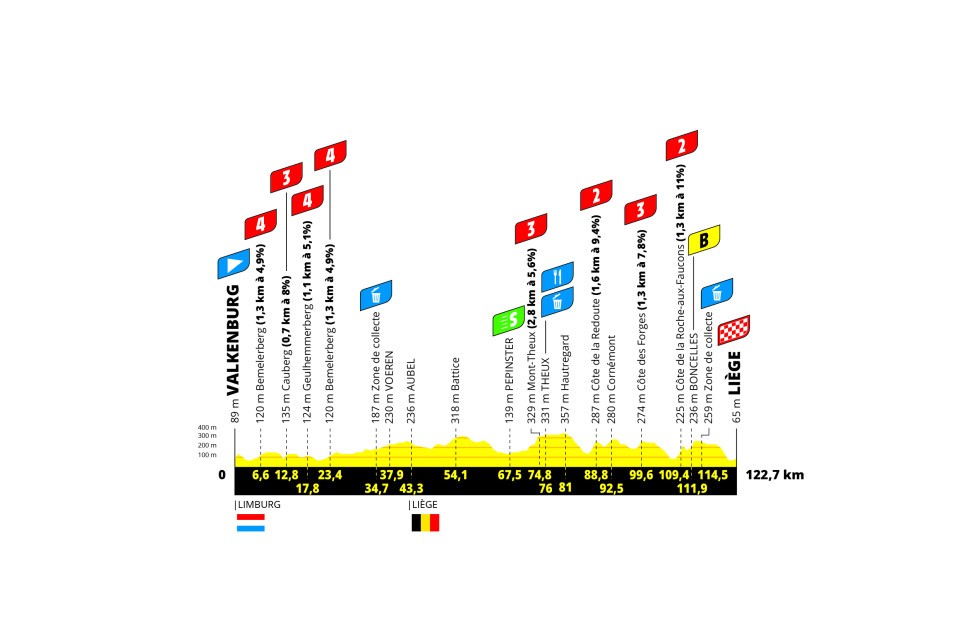
The final 50 km will yet again be familiar to those who have raced Liège-Bastogne-Liège. About 29 km after crossing into Belgium from the Netherlands the women will race up Mont-Theux, a 2.8 km climb that averages 5.6% but maxes out at 12%. This will kick off a challenging second half of the race that will see the GC contenders and their teams keen to stay in the front while plenty of riders try to sneak away for a stage win.
The final three climbs mimic the finale of Liège-Bastogne-Liège, a race that normally favours the climber-types of the peloton. That starts with the Côte de la Redoute (1.6 km, 9.4%) which normally plays a big role in the finale of the final one-day race of the spring. The maximum gradient on the climb is a staggering 16.8% with the steepest sections both in the middle and at the top. It's a fantastic launching point for attacks, as Lizzie Deignan, Annemiek van Vleuten and Demi Vollering will tell you.
Less than 10 km after the summit of the Côte de la Redoute the women hit the Côte des Forges. The 1.3 km climb averages 7.8% and reaches a maximum of 11%. It's not as challenging as the climbs before and after, but will definitely do a number on those barely hanging onto the peloton by this point in the race.
The final Cat 2 of the day, the Côte de la Roche-Aux-Faucons (1.3 km, 11%) tops out with 13.3 km left in the stage. It's the same finale as Liège-Bastogne-Liège, so we can expect a select group to come to the line unless an opportunistic rider gets away on those final climbs or in the final push to the finish.
Stage 5: Bastogne to Amnéville (152.5 km)
Date: Thursday, August 15
Stage type: Flat
Summary: An in-between stage with some climbing, but most importantly, we're in France!
For the fifth stage, the peloton will finally be setting foot on French soil. After starting in Bastogne, they will race 152.5 km and cross into France around 64 km into the stage.
The fifth stage isn't as hilly as the fourth but does include some Cat 4s scattered throughout the stage. The longest of the five climbs is 1.7 km (averaging 6%) with 15 km to go to the finish. To make this final climb even more spicy, there is a "bonus" climb, with bonus seconds on offer, 2 km after the official categorized summit.

The finish in Amnéville is a short uphill lunge to the line and depending on how those final climbs are raced, it could go to a reduced group. There are a few different ways this stage could go. With three big stages coming up, GC teams might want to conserve as much energy as they can before the real battle for yellow begins. This would favour a breakaway taking the stage. On the flip side, stage 5 might be one final opportunity for the sprinters, especially the ones who aren't afraid of that final climb.
Stage 6: Remiremont to Morteau (159.2 km)
Date: Friday, August 16
Stage type: Hilly
Summary: An appetizer before the big mountain stages.
The sixth stage is far from a mountainous stage but is the toughest finale so far in the race, with two categorized climbs in the final 30 km plus another time-bonus climb. It will be a fun warm-up for the GC riders and their teams before the final two stages of this year's Tour.
Just 11.7 km into the 159.2 km stage the women will take on the first categorized climb of the race, a Cat 3. The Col du Mont de Fourche is 3.2 km long and averages 5.9%, with maximum gradients of 17.8%. There is a tricky little twisting descent off of this climb as well, so GC teams will want to keep their riders at the front early in the stage.
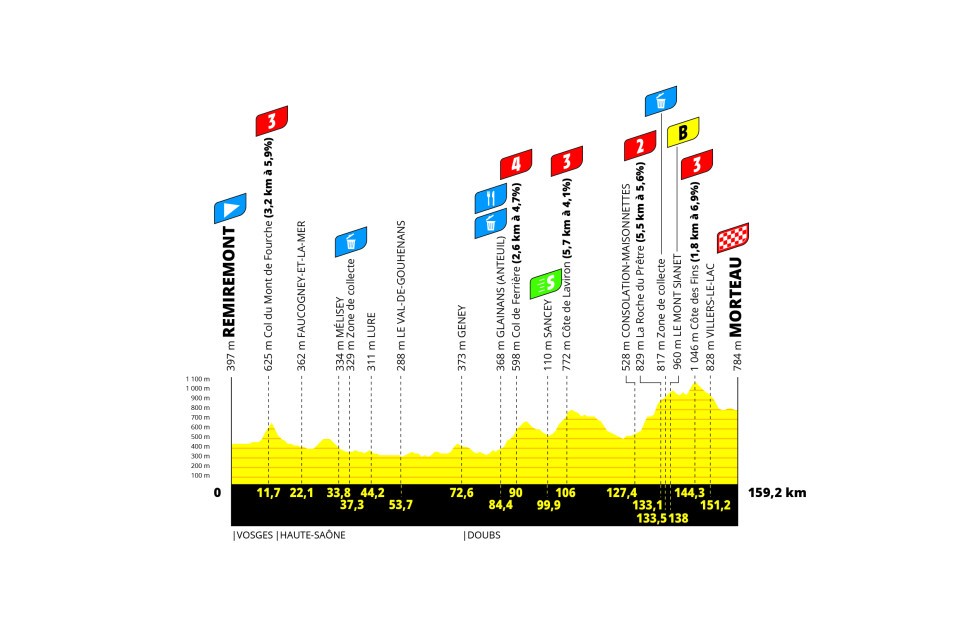
After the first climb the peloton has a good 63 km to catch their breath, try some attacking if the move of the day isn't already clear, and set up for the second half of the stage. While the final 30 km is the most challenging, there are two climbs before the race even reaches that point. First is the Col de Ferrière, a 2.6 km Cat 4 that averages 4.7%, and then the Côte de Laviron which is 5.7 km at 4.1%.
These two ascents are back to back, there is only a descent between them, they will make the finale even more challenging because they will distance key domestiques for certain riders and allow the peloton to find weak spots to attack.
Once the peloton descends off of Côte de Laviron they have about 10 km to regroup and reassess before the Cat 2, the longest climb of the day, of La Roche dy Prêtre. This 5.5 km climb has a 5.6% average and reaches gradients of 12%, but the stats are not what makes it critical. Once the riders have crossed the summit of the climb the road continues to rise for another 4 km. This is where the bonus climb is, with bonus seconds on the line.
One dip downwards and the riders climb again, this time a 1.8 km long Cat 3 that averages 6.9%. It's this final kick in the legs that will distance the majority of riders and see either a gutsy solo move to the line or a select group of favourites. From the top of the Côte des Fins, it's downhill to the line, with only 5 km of flat between the base of the descent and the finish line.
Stage 7: Champagnole to Le Grand-Bornand (166.4 km)
Date: Saturday, August 17
Stage type: Mountains
Summary: The first of two big mountain stages, and the longest stage of the race.
The seventh stage marks the beginning of the end of the Tour, with the last two days reserved for the general classification fight, the final stages are guaranteed to be exciting.
The stage starts with a gradual 15 km climb almost from the word "go," then descends to the first Cat 1 of the day. The Col de la Croix de la Serra is a 12 km long ascent averaging 5.1% but reaches pitches upwards of 20%. The climb is a constantly changing grade so there is no way to get into a rhythm. It will be in and out of the saddle and benefit the true climbers who can accelerate and slow down on climbs. For those climbers who are better at a measured steady effort, this one will be a challenge, but luckily for them, it's still early in the stage.
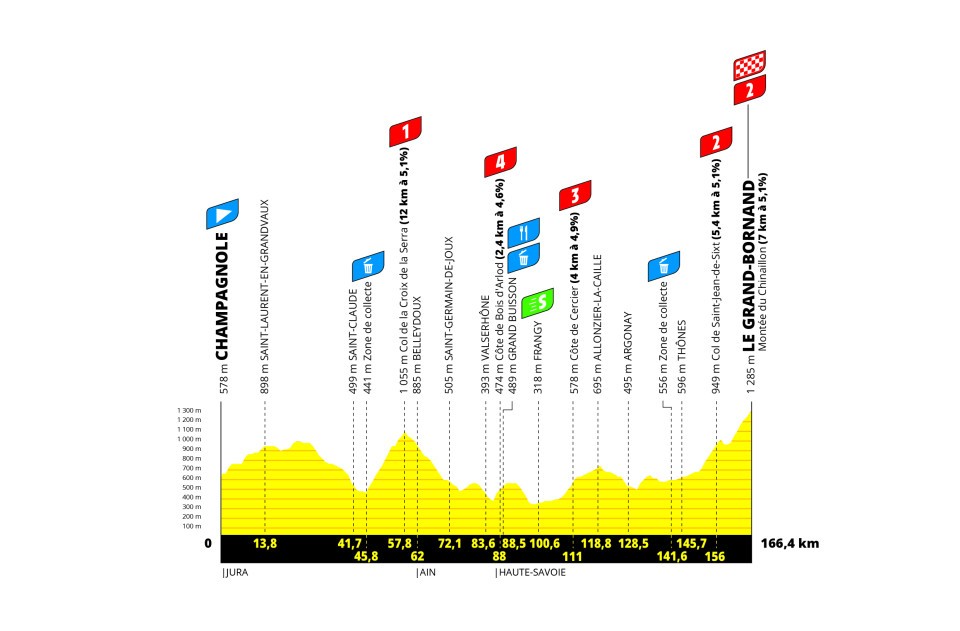
There are two climbs after the Col de la Croix de la Serra, the Cat 4 Côte de Bois d'Arlod (2.4 km, 4.6%) and Cat 3 Côte de Cercier (4 km, 4.8%). Because the stage is so long, these are not likely to make any more of an impact than just adding to fatigue before the final "two" climbs of the race. They're not inconsequential, but the riders will be more worried about the climb before and after.
The final two ascents are kind of just one long climb, with a small dip in the middle. From the moment descend off the Côte de Cercier they will start gearing up for the Col de Saint-Jean-de-Sixt, a 5.4 km climb averaging 5.1%. From the summit, the riders descend about 2 km before they start the next climb, a Cat 2 lasting 12 km and averaging 5.1%. The Grand Bornand-Le Chinaillon is 7 km long and averages 5.1%, with maximum grades of 12.8%. Unlike the first climb of the day, this one is more steady and gradual.
On their own, the two Cat 2s that finish the stage aren't that scary, but the 2 km of descending between them will only do so much for recovery, with very little opportunity for any dropped riders to catch on. Basically, with 16 km remaining in the stage, there is 14 km of climbing.
The seventh stage isn't as GC-centred as the queen stage that follows it, but between the length of the stage and the 2,980 m of elevation gain, it's a big day for the women and will see some GC hopefuls slip too far down the results to factor in Sunday's stage.
Stage 8: Le Grand-Bornand to Alpe d'Huez (150 km)
Date: Sunday, August 18
Stage type: Mountains
Summary: The big one.
After the seventh stage riders will be happy to see that the final stage of the Tour starts with a 78 km stretch of relative ease, with only one Cat 2 climb 18.2 km into the stage.
The Col de Tamié is a gradual 9.4 km ascent to kick things off but is the only real test in the opening kilometres of the stage. It's the second half of the stage that promises a real fight, with two HC climbs, the second of which is the famous Alpe d'Huez. What better place to crown this year's yellow jersey than this iconic climb?
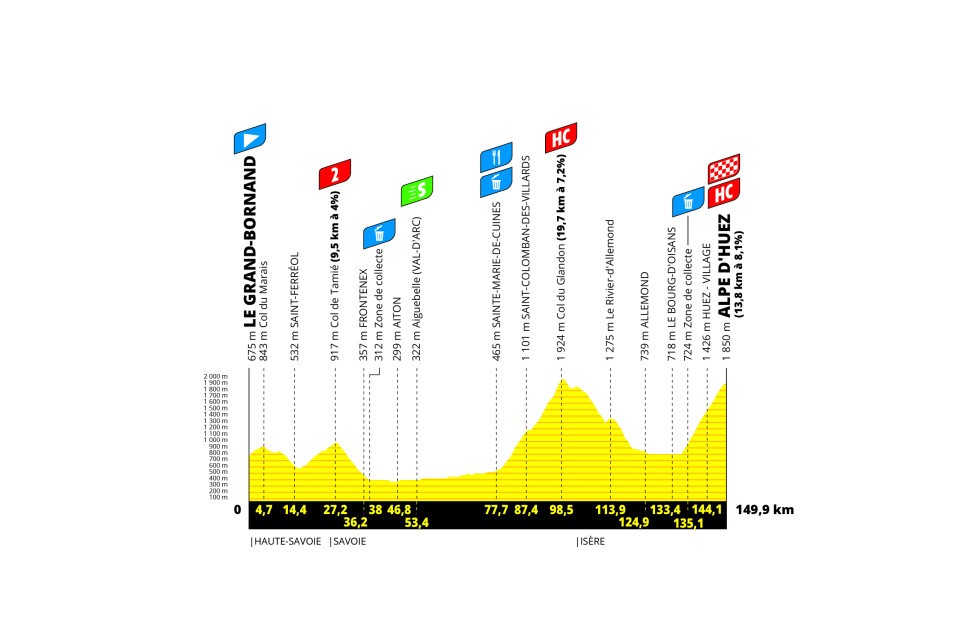
With 71 km to go the women start climbing the Col du Glandon, a 19.8 km long HC climb averaging 7.2%. Kind of like the Cat 1 from Saturday, this climb is constantly changing, with the steepest grades reaching upwards of 20% in the first half of the climb. There is very little easing into the ascent, as the most challenging section is early on with some steep sections near the mid-way point as well.
This climb is far enough from the finish that it's likely to be a repeat of what we saw in this year's Giro stage 7, where teams protected their leaders by controlling the pace and the GC favourites waited until the final climb of the day to attack each other. However, this climb is a lot steeper than Passo Lanciano in the Giro, and it will depend on how the GC riders are feeling about each other.
By Alpe d'Huez the gloves are off and it's every woman for themselves. This 13.7 km long climb averaging 8% reaches 32%. It is going to be a brutal climb, and the final 13.7 km of the race, so there will be no holding back. Last year we had a final time trial after Col du Tourmalet, but this year Alpe d'Huez is it.
Similar to the last two years the Tour's organizers have opted to place the most challenging stages, the stages that will change the general classification, at the end of the race. This means we will likely see the yellow jersey change hands multiple times, with bonus seconds on the lineup until the final two stages.
The top riders in the world will line up in Rotterdam, fresh from the Olympic Games, with everything to prove and one of the most prestigious jerseys in cycling on offer. Each day favours different riders, and each time will have its own ambition. All of this will come together for a week of fantastic bike racing.
Check Escape Collective closer to the race for a full contender preview, riders to watch in the general classification, stage hunters and sprinters, plus daily stage previews before each stage. And don't miss Wheel Talk's daily podcasts from the race, with audio diaries from top riders.
Did we do a good job with this story?

